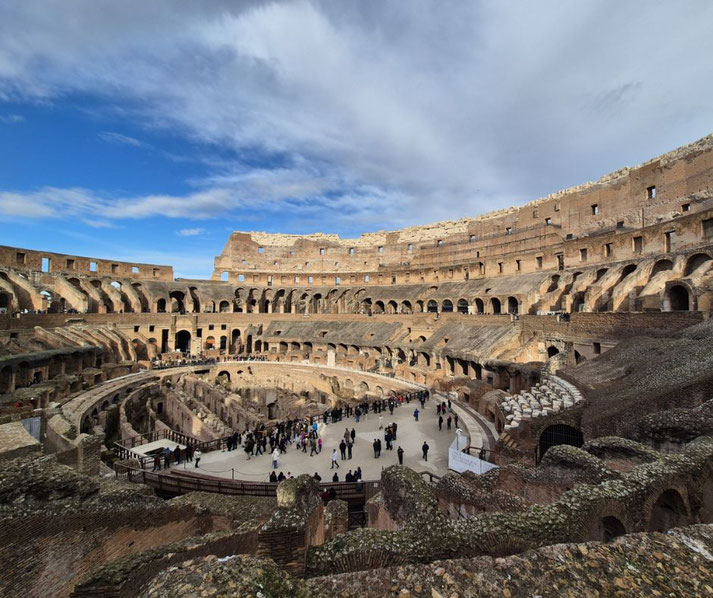When the Colosseum was flooded so that the Romans could watch a mock naval battle

The Colosseum in Rome, Italy, is one of the most famous symbols of ancient Rome. It first opened almost 2,000 years ago and hosted different kinds of shows such as gladiator fights and wild animal hunts.
One of the most interesting and less well-known events held there was the sea battles on a pool created inside the arena.
Romans called them naumachiae.
What were 'naumachiae'?
Naumachiae were mock sea battles that took place in an arena that the Romans built or modified to hold water to turn it into a large pool.
These events must have been carefully planned, and apparently included detailed sets and performances which copied real sea scenes.
According to ancient accounts, the fights were often planned so that the ships attacked each other with hooks, catapults and ballistae.
The point of the Roman naumachiae was to show the emperor’s power and financial resources in being able to afford such an incredible engineering feat, and, by extension, displayed the empire’s military strength on both land and in water.
Naumachiae before the Colosseum was built
The first recorded naumachia happened in 46 BC under Julius Caesar. It featured a battle between Egyptian and Tyrian ships on an artificial lake near the Campus Martius in Rome.
The next, in 2 BC, was when Augustus sponsored one on the Tiber River, where he had a dedicated basin structure built. This recreated a sea fight between Athenian and Persian forces.
In AD 52, Emperor Claudius also held a mock sea battle on Lake Fucino, which involved around 100 ships and about 19,000 participants.

The building of the Colosseum
Construction of the Colosseum started in AD 72 under Emperor Vespasian and finished in AD 80 under his son, Titus.
They built it on the site of an earlier artificial lake in central Rome, which had been part of Emperor Nero’s grand ‘golen palace’.
However, an entertainment building of its size and scale had even been built in the city before.
It was a large oval structure about 188 metres long and 156 metres wide, and stood 48 metres high.
To support its weight and design, builders had to use a combination of concrete, travertine and tuff.
When completed, it was encased in an outer layer of gleaming, white marble.
While we call it the Colosseum, the Romans referred to it as the Flavian Amphitheatre.
It held up to 80,000 people and hosted a range of shows which included gladiator fights, animal hunts and, of course, naumachiae.
The entire structure was designed with the audience in mind. Apart from its central location at the south-east end of the Forum, it had 80 entrances and exits, and even had a retractable roof awning to protect people from hot Mediterranean sun or seasonal rain showers.
Naval battles in the Colosseum
The first sea battle in the Colosseum took place in AD 80 as part of the opening of the arena. It involved more than 3,000 men and many ships.
It was so popular that later emperors repeated it several times, and gradually refined the sets and choreography over time.
To achieve this, they filled the arena floor with water and set up scenes that showed ports, islands and even cities.
The ships were smaller versions of real warships and were sailed by prisoners, slaves or criminals who had already been sentenced to death.
Viewers sat around the edge of the water and watched ships crash and sink, while fighters fought to the death on the wooden decks.
Archaeological evidence
As spectacular as these shows must have been, and as amazed as the ancient authors were when they described them, there is actually no physical proof that naumachiae ever took place in the Colosseum.
This is probably no surprise, as over time, the arena floor had been changed several times.
When it was originally opened, the Colosseum’s floor was flat and could have been filled with water when required.
However, during the reign of Emperor Domitian (Titus's younger brother), who ruled from AD 81 to 96, he dug out the flooring and added an underground area called the hypogeum.
This area was a two-level network of tunnels, cages, and service corridors that was used to house gladiators, animals, and equipment.
It also included some sophisticated machinery such as elevators and trapdoors to enable dramatic appearances in the arena above.
As a result of these changes, the original ground floor no longer existed.
Therefore, modern experts cannot tell how the Romans would have been able to make it watertight.
It is also not clear how they filled and emptied the space so quickly. Regardless, some historians still believe the shows took place because of written accounts by the people who were alive at the time and would have seen them first-hand.
Among this was Suetonius, a Roman historian, who provides the best description of a naval fight in the arena.
What is more, examples of these events appear in ancient art and on coins.

Decline in popularity
Despite their appeal, the sea battles became more controversial as Christianity grew in the later Empire and many opposed such violent and costly shows.
Using prisoners and slaves as fighters seemed wrong, especially as many died during the events.
In time, money troubles made naumachiae less common. Finally, emperors like Diocletian and Constantine focused more on gladiators and chariot races than on costly fake sea battles.
What do you need help with?
Download ready-to-use digital learning resources
Copyright © History Skills 2014-2025.
Contact via email
With the exception of links to external sites, some historical sources and extracts from specific publications, all content on this website is copyrighted by History Skills. This content may not be copied, republished or redistributed without written permission from the website creator. Please use the Contact page to obtain relevant permission.





